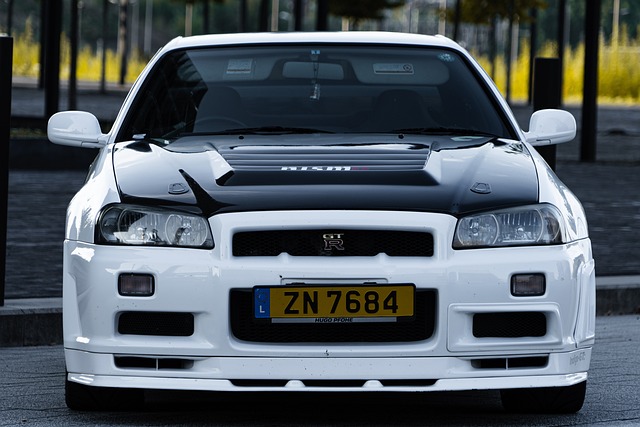JDM (Japanese Domestic Market) cars captivate global enthusiasts with their unique blend of performance, design, and cultural heritage. Models like Toyota Supra, Nissan Skyline GT-R, and Mazda RX-7 of…….
Category: Select JDM Cars
Select JDM Cars: A Comprehensive Analysis
Introduction
In the dynamic world of automotive engineering, ‘Select JDM Cars’ stands as a captivating segment that has garnered significant attention from enthusiasts, collectors, and industry experts alike. This article aims to take readers on an in-depth journey through the intricacies of this specialized category, exploring its historical roots, global impact, technological innovations, and the challenges it faces. By delving into these aspects, we will uncover why ‘Select JDM Cars’ holds such a unique place in the automotive landscape and what the future may hold for this captivating segment.
Understanding Select JDM Cars: Unveiling the Essence
Definition: Select JDM (Japanese Domestic Market) cars refer to a curated collection of vehicles produced and marketed exclusively within Japan, catering to the specific preferences and regulations of the Japanese market. These cars are renowned for their unique design aesthetics, advanced engineering, and often, limited availability globally.
Core Components: The essence of Select JDM Cars lies in several key components:
-
Market Segmentation: Japan has a distinct automotive market with diverse consumer preferences. Manufacturers tailor their vehicles to meet these demands, resulting in models that may not be identical or readily available in other regions.
-
Regulatory Compliance: Japanese vehicles must adhere to stringent safety and emission standards set by the country’s regulatory bodies. These regulations often drive technological advancements and innovative engineering solutions.
-
Limited Production and Availability: Many JDM cars are produced in limited quantities, further enhancing their exclusivity. This strategic move allows manufacturers to focus on quality and cater to a niche audience.
Historical Context: The concept of Select JDM Cars has its roots in post-World War II Japan, when the automotive industry began to flourish. Over time, Japanese car manufacturers like Toyota, Nissan, and Honda developed models with distinct features, catering to local tastes. These early JDM cars were known for their reliability and unique styling, setting the stage for the specialized segment we recognize today.
Global Impact and Trends: A World of Influence
The global impact of Select JDM Cars is profound, as it has left an indelible mark on the automotive industry worldwide:
-
Cultural Exchange: JDM cars have played a pivotal role in cultural exchange, introducing unique design elements, performance features, and engineering innovations to international markets. Many global automakers have drawn inspiration from Japanese models, leading to a fusion of styles and technologies.
-
Market Diversification: The success of Select JDM Cars has encouraged automobile manufacturers to diversify their offerings, recognizing the potential in catering to niche markets with specialized vehicles. This trend has resulted in a more varied global automotive landscape.
-
Performance and Technology: Japanese automakers are renowned for their precision engineering and focus on performance. Technologies such as all-wheel drive systems, advanced safety features, and fuel-efficient engines have become mainstream due to the influence of JDM cars.
Regional Trends: Different regions have embraced Select JDM Cars in unique ways:
| Region | Trend/Impact | Example |
|---|---|---|
| North America | Rising popularity of compact and sporty JDM models | The Nissan Silvia and Mazda MX-5 Miata have gained a dedicated following, influencing the design and performance of comparable vehicles. |
| Europe | Appreciation for JDM cars’ unique styling and handling | Japanese brands like Toyota and Subaru have established strong presences in European markets, with models like the Impreza WRX STI becoming iconic rally cars. |
| Asia (Outside Japan) | Emphasis on advanced technology and safety | South Korean automakers have adopted Japanese engineering principles, resulting in vehicles with superior fuel efficiency and advanced driver-assistance systems. |
Economic Considerations: Powering the Automotive Sector
The economic aspects of Select JDM Cars are multifaceted, influencing both domestic and international markets:
-
Market Dynamics: The demand for JDM cars has created a vibrant subculture among automotive enthusiasts, driving up prices and fostering a secondary market. Rare models can fetch premium prices at auctions and dealership sales.
-
Investment Patterns: Collectible JDM cars have become attractive investment opportunities. Their limited availability, historical significance, and performance capabilities make them valuable assets for investors.
-
Economic Impact on Japan: The domestic automotive industry is a significant contributor to Japan’s economy. Select JDM Cars play a role in this success by attracting global attention and fostering international trade.
Technological Advancements: Driving Innovation Forward
Japanese automakers have been at the forefront of technological innovation, and Select JDM Cars showcase many groundbreaking advancements:
-
Hybrid and Electric Vehicles: Toyota’s Prius, one of the most iconic JDM cars, revolutionized hybrid technology. This model introduced a new era of fuel-efficient and eco-conscious vehicles, setting benchmarks for other automakers worldwide.
-
All-Wheel Drive Systems: Many JDM cars feature sophisticated all-wheel-drive systems, enhancing handling and traction in various driving conditions. Subaru’s Symmetrical All-Wheel Drive is a prime example, offering superior performance in snow and off-road scenarios.
-
Safety Features: Japanese manufacturers have consistently pushed the boundaries of active and passive safety features. Advanced airbag systems, pre-collision warning systems, and lane departure warnings are now standard across many JDM models, setting global safety standards.
Policy and Regulation: Shaping the JDM Landscape
Government policies and regulations significantly influence the development and availability of Select JDM Cars:
-
Import Restrictions: Many countries have strict import regulations, which can limit or prohibit the entry of certain JDM cars. These restrictions are often based on safety, environmental, and tax considerations.
-
Emission Standards: Japan’s stringent emission standards have driven technological advancements in fuel efficiency and cleaner engines. Automakers must comply with these regulations to ensure their vehicles’ global marketability.
-
Safety Regulations: The Japanese government’s focus on vehicle safety has led to rigorous testing and certification processes. Manufacturers invest heavily in research and development to meet these standards, resulting in safer JDM cars.
Challenges and Criticisms: Overcoming Obstacles
Despite its success, Select JDM Cars faces several challenges:
-
Limited Availability: One of the primary criticisms is the restricted access to these vehicles globally. Importing specific JDM models can be costly and time-consuming, limiting their availability outside Japan.
-
Cultural Misunderstanding: Some JDM cars’ unique design elements and features may not align with global market preferences, leading to potential misunderstandings among consumers.
-
Maintenance and Parts Availability: Owning a rare JDM car can present challenges in terms of maintenance and accessing genuine parts, as supply chains may be limited or specialized.
Proposed Solutions: To overcome these issues:
-
Digitalization of Import Processes: Streamlining import procedures and utilizing digital platforms can expedite the availability of JDM cars globally.
-
Cultural Sensitivity in Design: Automakers should consider global market preferences while preserving the essence of JDM designs to ensure wider appeal.
-
Part Distribution Networks: Building robust networks for parts distribution and maintenance support can enhance the ownership experience for JDM car enthusiasts.
Case Studies: Real-World Success Stories
Case Study 1: Toyota Celica GT-Four (1994)
The Toyota Celica GT-Four, introduced in Japan in 1994, is a testament to the success of Select JDM Cars. This all-wheel-drive sports coupe combined advanced technology with captivating performance. Its unique traction control system and precision handling made it a favorite among racing enthusiasts. The Celica GT-Four’s impact extended beyond Japan, as its performance inspired similar models globally, solidifying its place in automotive history.
Case Study 2: Nissan Skyline GT-R (2007)
The third generation of the iconic Nissan Skyline GT-R is another standout example. This high-performance sports car featured an advanced twin-turbo V6 engine and all-wheel-drive system, delivering unparalleled acceleration and handling. The GT-R’s success led to its export to various markets, becoming a symbol of Japanese automotive excellence. Its impact on the supercar segment cannot be overstated, as it set new benchmarks for performance and technology.
Future Prospects: Looking Ahead
The future of Select JDM Cars is filled with potential growth areas and emerging trends:
-
Electric and Sustainable Vehicles: As the global focus shifts towards sustainability, Japanese automakers will likely lead in developing electric and hybrid JDM cars, building on their existing expertise in these technologies.
-
Autonomous and Connected Cars: The integration of advanced driver-assistance systems (ADAS) and autonomous driving capabilities will be a significant trend, with JDM cars at the forefront of this evolution.
-
Global Market Expansion: With improving digital connectivity and streamlined import processes, Select JDM Cars are poised to expand their global reach, captivating new audiences.
Conclusion: A Journey of Engineering Excellence
‘Select JDM Cars’ represents a unique chapter in the history of automotive engineering, where precision, innovation, and cultural flair converge. From its humble beginnings to its current global influence, this segment has left an indelible mark on the industry. As technology continues to evolve and market dynamics shift, Select JDM Cars will undoubtedly adapt and thrive, offering enthusiasts and collectors alike a fascinating journey through automotive excellence.
FAQ Section: Answering Your Questions
Q: What makes a car a “Select JDM Car”?
A: A Select JDM Car is a vehicle produced and marketed exclusively in Japan, with unique design, engineering, or performance features tailored to the local market. Limited availability globally sets it apart from mainstream models.
Q: Are all JDM cars rare and expensive?
A: Not all JDM cars are rare or expensive. While some limited-edition models command high prices, many JDM vehicles are relatively common within Japan but may be harder to find internationally due to import restrictions.
Q: Can I modify a Select JDM Car to make it more powerful?
A: Modifying JDM cars is a complex process, and regulations vary by region. While some modifications are possible, ensuring compliance with local laws and maintaining the car’s original integrity is crucial for safety and resale value.
Q: Are JDM cars known for their reliability?
A: Yes, Japanese automakers have a reputation for producing reliable vehicles. Select JDM Cars, in particular, often benefit from rigorous engineering standards and meticulous craftsmanship, contributing to their long-term dependability.
Q: How can I find genuine parts for my rare JDM car?
A: Building a network of specialized dealerships, online forums, and automotive communities can help locate genuine parts. Some manufacturers also offer replacement parts specifically for older models through their official channels.
Discovering JDM Cars: Enthusiasts’ Ultimate High-End Choice
Selecting JDM (Japanese Domestic Market) cars combines performance and aesthetics, appealing to high-end enthusiasts for their precision engineering, innovative tech, and unique specs. Brands like Toy…….
Revolutionize Your Drive: Unlocking JDM Tech Secrets
Discover high-performance Select JDM Cars renowned for speed and handling. Focus on safety features like forward collision warning and adaptive cruise control. Embrace sustainability with eco-friendly…….
Discovering JDM Cars: Unlocking High-End Driving Passion
High-end car enthusiasts are drawn to Select JDM Cars for their blend of performance, style, and innovation rooted in Japan's motorsport heritage. These cars, known for powerful engines, advanced…….
Unlocking JDM Potential: Expert Guide to Select and Maintain
Select JDM Cars offers a unique blend of traditional craftsmanship and modern customization, expertly restoring and enhancing iconic Japanese vehicles. Importing a JDM car requires knowledge of manufa…….
Unleashing Value: Select JDM Cars with Competitive Pricing Strategies
Selecting JDM cars involves understanding market dynamics where desirability, scarcity and performance drive pricing. Factors like make, model, year and condition influence values with top Japanese ma…….
Select JDM Cars: Transparent Buying Process Unveiled
The Japanese Domestic Market (JDM) car culture globally celebrates a unique blend of performance, aesthetics, and innovation in select JDM cars. This has led to a surge in demand from collectors and m…….
Discovering Certified Pre-Owned JDM Cars: Select Your Dream
The global JDM car market, driven by performance, tech, and style, caters to enthusiasts who value legacy. Certified pre-owned Select JDM Cars offer peace of mind with rigorous inspections, warranties…….
Select JDM Cars: Trustworthy Dealers for Authentic Vehicles
Selecting JDM cars involves choosing reputable dealers who prioritize transparency and expertise. Research their reputation, shipping capabilities, and knowledge of Japanese car trends for a trustwort…….
JDM Car Upgrades: Speed, Handling, and Style Unlocked
Unleash the unique potential of Select JDM Cars through specialized upgrades inspired by vintage Japanese motorcycles. Transmission tuning optimizes performance and efficiency while suspension refinem…….









